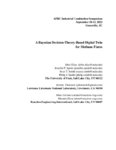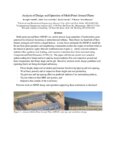TO
Filters: Publication Type: "report" Research Institute: "American Flame Research Committee (AFRC)" Collection: ir_eua
| Title | Date | Subject | Description | ||
|---|---|---|---|---|---|
| 1 |
 |
3D CFD model development and validation for once-through steam generator (OTSG): coupling combustion, heat transfer | The current research studies the coupled combustion inside the furnace and the steam generation inside the radiant and convection tubes through a typical Once-Through Steam Generator (OTSG). A 3D CFD model coupling combustion and two-phase flow was developed to model the entire system of OTSG. Once ... | ||
| 2 |
 |
A bayesian decision-theory-based digital twin for methane flares | 2022 | Ground flares operate in a high-turndown, standby configuration for a significant portion of their operating life, being fully utilized only under process upset scenarios or emergencies. The low-momentum flow results in poor fuel-air mixing near the flare tip, leading to decreased overall combustion... | |
| 3 |
 |
A chemical kinetics approach for heavy fuel oils gasification modelling | 2022 | surrogate; HFOs; pyrolysis; chemical kinetics modeling; Gassification | Refinery oil residue commonly considered the bottom of the barrel, can no longer be a waste. The increasing energy demand and the constant depletion of light oil supply make it crucial to find a suitable way to convert residual oils into valuable fuels. The gasification process represents a possible... |
| 4 |
 |
A comprehensive parametric investigation of efficient soot modeling using high fidelity method of moments | PSD; PAH; nucleation; Soot; Radiation; Method of moment | Soot is one of the most regulated pollutants in all the combustion applications like automotive engines, aviation engines, and industrial furnaces. Modeling soot formation is quite challenging due to the complex processes involved in the formation of the soot particulates. Empirical formulation base... | |
| 5 |
 |
A volume of fluid approach to model injection of highly viscous fluids | 2022 | Despite the transition to renewable energy sources, fossil fuels will still play a significant role in satisfying the world's energy needs shortly. In addition, the rise in the demand for light distillates and the depletion of light crude oil reservoirs are shifting the interest toward the conversio... | |
| 6 |
 |
Ammonia for industrial combustion | ammonia combustion; hydrogen; methane | Many companies are investigating switching from conventional fossil fuels to "green" fuels such as hydrogen to reduce CO2 emissions. This assumes hydrogen is made by an environmentally-friendly method such as electrolysis using renewable energy. However, there are concerns with hydrogen. For example... | |
| 7 |
 |
Analysis of burner operation inside an enclosed ground flare | 2022 | Thermo-Acoustic Coupling; Enclosed Flare; LES CFD Model; Noise; Premixed Burner | An industrial enclosed ground flare used as part of a large refinery project has been analyzed to assess combustion stability and performance under low and high flow conditions. This flare includes a large combustion chamber directly above the burner deck with Low Flow (LF) burners that fire up to 9... |
| 8 |
 |
Analysis of design and operation of multi-point ground flares | 2022 | Multi-point ground flares (MPGF) are used to process large quantities of hydrocarbon gases generated in chemical processing or petrochemical refining. These flares use hundreds of flare burners arranged and fired in a staged fashion. A wind fence surrounds the MPGF to shield the flames from plant op... | |
| 9 |
 |
Capturing the effect of near-and far-field dynamics on the combustion efficiency of multi-point ground flares | 2022 | Multi-point ground flares are frequently used in scenarios where flare gas flow rates can be high and pollution (noise, light, smoke) needs to be minimized. We have applied Arches, a large eddy simulation (LES) tool that we have developed for capturing the dynamics of flares (turbulent mixing, local... | |
| 10 |
 |
CFD development for fired heater applications | 2022 | Industry values the ability to ‘virtually' verify and optimize burner performance through CFD simulation and to evaluate the suitability of burner and furnace designs. Inaccurate results may lead us to falsely reject good burner designs or accept a poor design. Field problems can be far more expen... | |
| 11 |
 |
Clearn combustion, a path to net zero | Use of fossil fuels as the major source of energy is one of the main sources of GHG emissions that contribute to global warming. However, for at least a foreseeable future, the world will still continue to rely on fossil fuels to sustain the economy and the quality of life. IEA is evaluating the pat... | ||
| 12 |
 |
Coanda effect enhanced air assisted flare for low flow operation: cold flow CFD analysis | This paper aims at increasing the flow velocity in the flare stack by decreasing the flow diameter to solve the issue of low flow operation in the flares. A new air assisted flare design of 1m height and 15cm diameter has been tested using CFD simulation in this work. The design includes injecting a... | ||
| 13 |
 |
Combustion emissions and thermal performance impacts when replacing hydrocarbon fuels with hydrogen in industrial furnaces | Many industrial processes rely on heating that is currently achieved through combustion of fossil fuels. The industrial sector generates approximately 23 percent of the greenhouse gas emissions in the US. As infrastructure associated with production and distribution of hydrogen continues to expand, ... | ||
| 14 |
 |
Computational study of the anode baking industrial furnace | Turbulent flow; Eddy dissipation model; Combustion, NOx; Zeldovich mechanism | In the aluminium industry, the Hall-Héroult process is used for smelting of aluminium using carbon electrodes such as anodes. The baking process of anodes is required for their maximum efficiency during this electrolysis process. The anode baking process contributes up to 15% costs in the aluminium... | |
| 15 |
 |
Decarbonizing: the future of hydrogen firing | Historically, firing hydrogen fuel was only economical in certain applications outside of the power industry. Unlike other fossil fuels, hydrogen does not naturally exist as H2 and is commonly produced in hydrogen reformers and considered an energy carrier and not an energy source. Steam-methane ref... | ||
| 16 |
 |
Design Considerations for Carbon-Free Combustion | Decarbonization; Hydrogen Combustion; Carbon Dioxide; Carbon-Free Combustion; CO2 Emissions; Greenhouse Gas Emissions | Combustion of a hydrocarbon produces water and carbon dioxide. As consensus continues to build around the contributions of carbon in global client change, jurisdictions, both internationally as well as domestically, are working towards limiting formation of carbon dioxide. One way to work toward eff... | |
| 17 |
 |
Effect of operating parameters on fired heater tube skin temperature measurement accuracy & the development of new improved tube skin thermocouple | 2022 | Refineries are often faced with challenges to meet production target, improve efficiency, process opportunity crudes with limited information on fouling characteristics etc. The common parameter that often becomes constraining are the tube skin temperatures which are critical in maintaining the inte... | |
| 18 |
 |
Explaining the "three inch rule": why model flares don't match full-scale | 2022 | It was Pohl and co-workers who discovered the so-called "Three Inch Rule" in their work on flares in the 1980s. They found that model flares with pipe diameter less than three inches do not have the same Combustion Efficiency (CE) and stability behaviour as full-scale flares, at least when wind is n... | |
| 19 |
 |
Firing of liquid bio-derived fuels for decarbonization of high temperature industrial heating processes | Recent commitments to CO2/Green-House Gas emissions reductions by governmental, NGO and industrial corporations require that new energy sources be found to replace fossil fuels. While some are envisioning ‘The Electrification of Everything,' High temperature industrial heating processes have been ... | ||
| 20 |
 |
Hardening of arches for commercial simulation of industrial flares: a program update | Reaction Engineering International (REI) is working with the University of Utah to leverage the Uintah Computational Framework (UCF) for commercial simulation of industrial flares, with funding from the Department of Energy (DOE). The Arches component of the UCF provides a reacting large eddy simula... | ||
| 21 |
 |
Installation of lean premix and remote fuel staging system in industrial process heater for next generation nox emissions control | 2022 | John Zink Hamworthy Combustion (JZHC) has completed the first installation and startup of the SOLEX combustion system in the Vacuum Tower Feed Furnace at a GS Caltex refinery in South Korea. The patented SOLEX™ burner compromises a lean premix zone of combustion, where the air-to-fuel ratio (AFR) ... | |
| 22 |
 |
Investigative approach to address thermoacoustic vibration in gas-fired heaters and boilers | 2022 | Industrial gas-fired boilers, furnaces and heaters occasionally encounter low-frequency vibrations generated by dynamic feedback between the burner (or burners) and acoustic modes in adjacent cavities in the main combustion chamber or ductwork. Feedback occurs when pressure pulses associated with ac... | |
| 23 |
 |
Model-based design and full-scale demonstration of an oxy-coal firing system with undiluted oxygen and minimal flue gas recycle | The future use of coal as a fuel for industrial applications depends on economical technologies being made available to capture and store the CO2 emitted as a product of the combustion process. One such technology is oxy-combustion, which involves burning of the fuel using pure oxygen as the oxidant... | ||
| 24 |
 |
Modeling sulfur-Nitrogen chemistry indside a claus reaction furnace | This paper describes a CFD analysis of a Sulfur Recovery Unit (SRU) considering transient turbulent reacting flow inside the SRU. Often, the SRU feedstock includes hydrocarbons together with nitrogen and sulfur species, which react with oxygen in the air to form various emissions including SO2, NH3 ... | ||
| 25 |
 |
Quantifying flare combustion efficiency using an imaging fourier transform spectrometer | 2022 | Mid-wavelength infrared (MWIR) hyperspectral imaging may be used to calculate the flare combustion efficiency from standoff measurements, without requiring any information about the fuel flow rate to the flare. Species column densities are found using a spectroscopic model, which is combined with a ... |
